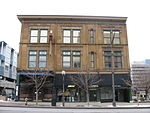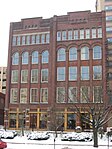Downtown Columbus, Ohio

Downtown Columbus is the central business district of Columbus, Ohio. Downtown is centered on the intersection of Broad and High Streets, and encompasses all of the area inside the Inner Belt. Downtown is home to most of the tallest buildings in Columbus. The state capitol, the Ohio Statehouse, is located in the center of downtown on Capitol Square. Downtown is also home to Columbus State Community College, Franklin University, Columbus College of Art and Design, Grant Medical Center, Capital University Law School, as well as the Main Library of the Columbus Metropolitan Library, the pioneering Main Street Bridge, and many parks. Downtown has many neighborhoods or districts, but it can be separated into three main areas: the Discovery District, the High Street Corridor, and the Riverfront. Downtown also includes the Arena District, Capitol Square, and the Columbus Civic Center. The Short North, Italian Village, and Victorian Village are directly north of downtown. Olde Towne East and King-Lincoln Bronzeville are directly east, while the Brewery District and German Village are directly south of Downtown. Franklinton is to the west of downtown. Almost 90,000 people are employed downtown, and more than 33,000 students attend school at one of the many institutions of higher education located there. As of 2022, Downtown is home to about 11,200 residents.
Excerpt from the Wikipedia article Downtown Columbus, Ohio (License: CC BY-SA 3.0, Authors, Images).Downtown Columbus, Ohio
East Spring Street, Columbus
Geographical coordinates (GPS) Address Nearby Places Show on map
Geographical coordinates (GPS)
| Latitude | Longitude |
|---|---|
| N 39.966694444444 ° | E -83 ° |
Address
East Spring Street 28
43215 Columbus
Ohio, United States
Open on Google Maps









